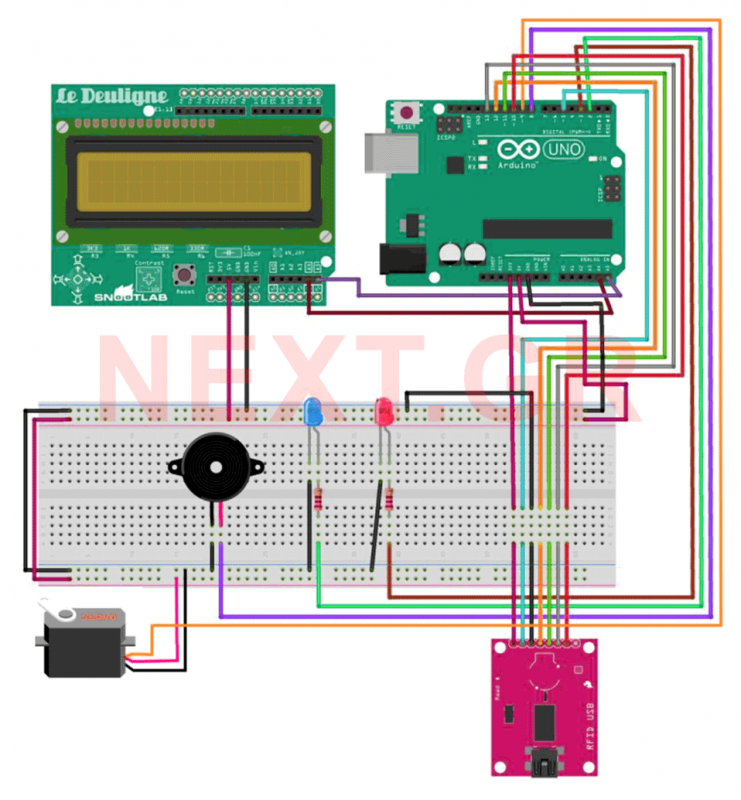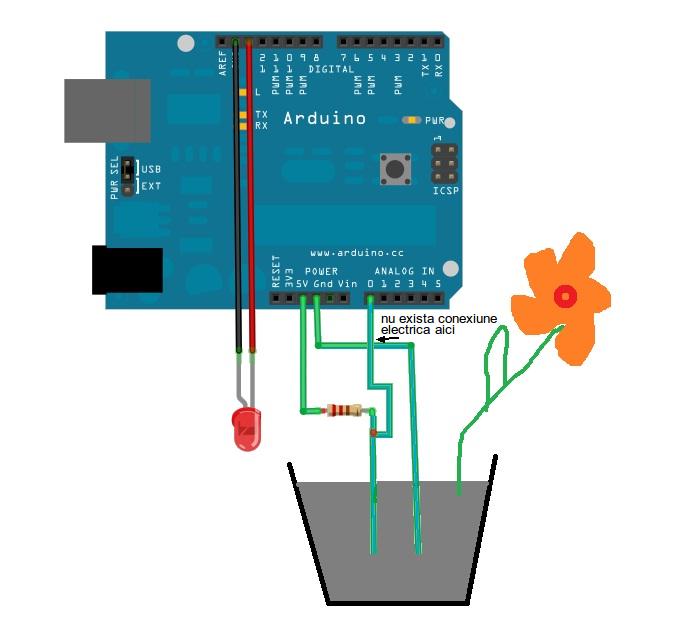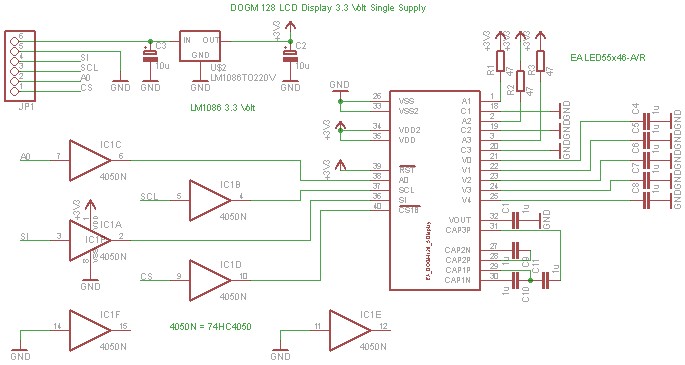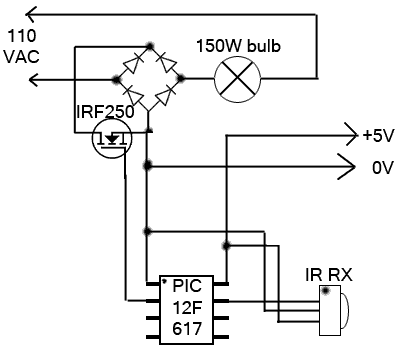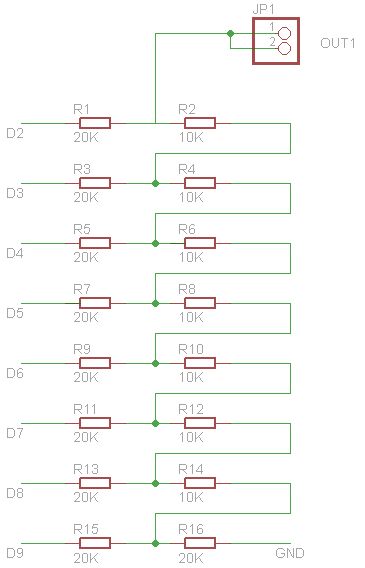
Arduino Analog Input
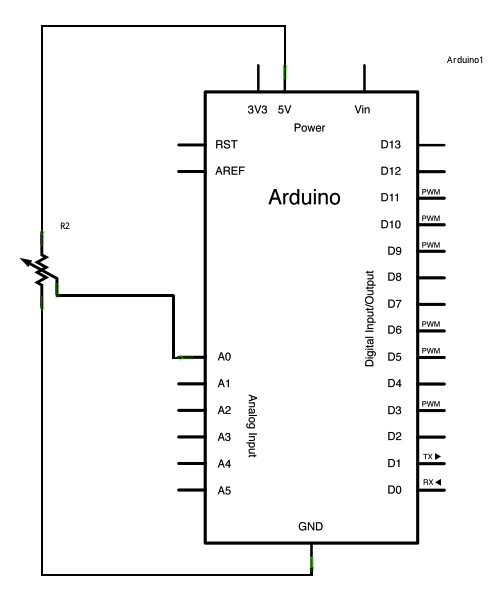
A potentiometer is a simple knob that provides variable resistance, which can be read into the Arduino board as an analog value. In this example, a potentiometer is connected to one of the Arduino's analog inputs to control the rate at which the built-in LED on pin 13 blinks. Three wires are connected to the Arduino board: the first wire goes to ground from one of the outer pins of the potentiometer, the second wire connects from 5 volts to the other outer pin of the potentiometer, and the third wire connects from analog input 0 to the middle pin of the potentiometer. The built-in LED on the Arduino board can be used, or an additional LED can be connected by attaching its longer leg (the anode) to digital pin 13 and its shorter leg (the cathode) to the ground pin next to pin 13. Due to the low current output from digital pin 13, a current limiting resistor is not necessary in this case. At the beginning of the program, the variable sensorPin is assigned to analog pin 0, where the potentiometer is connected, and ledPin is set to digital pin 13. An additional variable, sensorValue, is created to store the values read from the sensor. The analogRead() command converts the input voltage range of 0 to 5 volts into a digital value between 0 and 1023 using the Arduino's internal analog-to-digital converter (ADC). By turning the potentiometer's shaft, the resistance changes on either side of the center pin (or wiper), altering the resistances between the center pin and the two outer pins, which results in a different voltage at the analog input. When the shaft is turned fully in one direction, there is no resistance between the center pin and the ground pin, resulting in 0 volts at the center pin and an analogRead() return value of 0. Conversely, when the shaft is turned fully in the opposite direction, there is no resistance between the center pin and the +5 volts pin, resulting in 5 volts at the center pin and an analogRead() return value of 1023. For intermediate positions, analogRead() returns a value between 0 and 1023 that is proportional to the voltage at the pin. This value, stored in sensorValue, is used to set a delay() for the blink cycle, where a higher value results in a longer cycle and a smaller value results in a shorter cycle.
The described circuit utilizes a potentiometer to manipulate the blinking rate of an LED connected to an Arduino board. The potentiometer functions as a variable resistor, providing an adjustable voltage that is read by the Arduino's analog input. The connections are made as follows: the outer pins of the potentiometer are connected to the power supply (5V) and ground, while the middle pin (wiper) is connected to the analog input pin (A0) of the Arduino. This configuration allows the potentiometer to act as a voltage divider.
When the potentiometer is adjusted, it changes the voltage at the center pin, which is read by the Arduino using the analogRead() function. The Arduino's ADC converts this voltage into a digital value between 0 and 1023, corresponding to the voltage levels. The resulting digital value is then stored in the variable sensorValue.
The program uses this sensorValue to determine the delay between LED blinks. The built-in LED on pin 13 can be utilized directly, or an external LED can be added. If using an external LED, it is connected with its anode to pin 13 and cathode to ground. Given the low current output from pin 13, a current-limiting resistor is not required.
As the user rotates the potentiometer, they can observe the LED blinking at varying rates, demonstrating the relationship between resistance, voltage, and the resulting output behavior of the LED. This circuit serves as an excellent introduction to analog input reading and control of digital outputs using a simple and effective interface.A potentiometer is a simple knob that provides a variable resistance, which you can read into the Arduino board as an analog value. In this example, you`ll connect a poterntiometer to one of the Arduino`s analog inputs to control the rate at which the built-in LED on pin 13 blinks.
Connect three wires to the Arduino board. The first goes to ground from one of the outer pins of the potentiometer. The second goes from 5 volts to the other outer pin of the potentiometer. The third goes from analog input 0 to the middle pin of the potentiometer. For this example, it is possible to use the Arduino board`s built in LED attached to pin 13. To use an additional LED, attach its longer leg (the positive leg, or anode), to digital pin 13, and it`s shorter leg (the negative leg, or cathode) to the ground (gnd) pin next to pin 13. Because of the low amount of current coming from digital pin 13, it is not necessary to use a current limiting resistor in this particular case.
In the beginning of this program, the variable sensorPin is set to to analog pin 0, where your potentiometer is attached, and ledPin is set to digital pin 13. You`ll also create another variable, sensorValue i to store the values read from your sensor. The analogRead() command converts the input voltage range, 0 to 5 volts, to a digital value between 0 and 1023.
This is done by a circuit inside the Arduino called an analog-to-digital converter or ADC. By turning the shaft of the potentiometer, you change the amount of resistance on either side of the center pin (or wiper) of the potentiometer. This changes the relative resistances between the center pin and the two outside pins, giving you a different voltage at the analog input.
When the shaft is turned all the way in one direction, there is no resistance between the center pin and the pin connected to ground. The voltage at the center pin then is 0 volts, and analogRead() returns 0. When the shaft is turned all the way in the other direction, there is no resistance between the center pin and the pin connected to +5 volts.
The voltage at the center pin then is 5 volts, and analogRead() returns 1023. In between, analogRead() returns a number between 0 and 1023 that is proportional to the amount of voltage being applied to the pin. That value, stored in sensorValue, is used to set a delay() for your blink cycle. The higher the value, the longer the cycle, the smaller the value, the shorter the cycle. 🔗 External reference
The described circuit utilizes a potentiometer to manipulate the blinking rate of an LED connected to an Arduino board. The potentiometer functions as a variable resistor, providing an adjustable voltage that is read by the Arduino's analog input. The connections are made as follows: the outer pins of the potentiometer are connected to the power supply (5V) and ground, while the middle pin (wiper) is connected to the analog input pin (A0) of the Arduino. This configuration allows the potentiometer to act as a voltage divider.
When the potentiometer is adjusted, it changes the voltage at the center pin, which is read by the Arduino using the analogRead() function. The Arduino's ADC converts this voltage into a digital value between 0 and 1023, corresponding to the voltage levels. The resulting digital value is then stored in the variable sensorValue.
The program uses this sensorValue to determine the delay between LED blinks. The built-in LED on pin 13 can be utilized directly, or an external LED can be added. If using an external LED, it is connected with its anode to pin 13 and cathode to ground. Given the low current output from pin 13, a current-limiting resistor is not required.
As the user rotates the potentiometer, they can observe the LED blinking at varying rates, demonstrating the relationship between resistance, voltage, and the resulting output behavior of the LED. This circuit serves as an excellent introduction to analog input reading and control of digital outputs using a simple and effective interface.A potentiometer is a simple knob that provides a variable resistance, which you can read into the Arduino board as an analog value. In this example, you`ll connect a poterntiometer to one of the Arduino`s analog inputs to control the rate at which the built-in LED on pin 13 blinks.
Connect three wires to the Arduino board. The first goes to ground from one of the outer pins of the potentiometer. The second goes from 5 volts to the other outer pin of the potentiometer. The third goes from analog input 0 to the middle pin of the potentiometer. For this example, it is possible to use the Arduino board`s built in LED attached to pin 13. To use an additional LED, attach its longer leg (the positive leg, or anode), to digital pin 13, and it`s shorter leg (the negative leg, or cathode) to the ground (gnd) pin next to pin 13. Because of the low amount of current coming from digital pin 13, it is not necessary to use a current limiting resistor in this particular case.
In the beginning of this program, the variable sensorPin is set to to analog pin 0, where your potentiometer is attached, and ledPin is set to digital pin 13. You`ll also create another variable, sensorValue i to store the values read from your sensor. The analogRead() command converts the input voltage range, 0 to 5 volts, to a digital value between 0 and 1023.
This is done by a circuit inside the Arduino called an analog-to-digital converter or ADC. By turning the shaft of the potentiometer, you change the amount of resistance on either side of the center pin (or wiper) of the potentiometer. This changes the relative resistances between the center pin and the two outside pins, giving you a different voltage at the analog input.
When the shaft is turned all the way in one direction, there is no resistance between the center pin and the pin connected to ground. The voltage at the center pin then is 0 volts, and analogRead() returns 0. When the shaft is turned all the way in the other direction, there is no resistance between the center pin and the pin connected to +5 volts.
The voltage at the center pin then is 5 volts, and analogRead() returns 1023. In between, analogRead() returns a number between 0 and 1023 that is proportional to the amount of voltage being applied to the pin. That value, stored in sensorValue, is used to set a delay() for your blink cycle. The higher the value, the longer the cycle, the smaller the value, the shorter the cycle. 🔗 External reference
